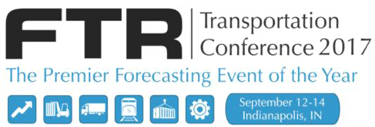Getting a read on the state of the economy was a key theme at last week's 2017 FTR Transportation Conference in Indianapolis. This annual event always does a terrific job of putting things into perspective, with insights coming from myriad industry stakeholders, including shippers, carriers, 3PLs, and analysts, among others.
The opening keynote, which was delivered by Larry Davidson, a professor at the Indiana University Kelly School of Business, pointed to the economy being in a state of secular stagnation at an average growth rate of 1.8% per year, or slow growth in other words.
Davidson explained that the key levers of economic growth are essentially the output of labor force growth and productivity that measure economic output on both a quarterly and annual basis.
“What is happening is that growth is happening but is slower than before, it is not a cycle, as much as it is a long-term thing,” he said. “The economy is sauntering along.”
This sauntering takes into account that 70% of GDP output is based on the services-based economy and not a good-based one, even though manufacturing data in the form of monthly readings from the Institute for Supply Management and the Federal Government's Industrial Production Index remain on solid footing.
But while the economy technically is growing and not in recession that does not mean that things are safe by any stretch either.
“Economic shocks can be unpredictable, and when things run out of gas that can lead to a profit squeeze,” said Davidson.
Another issue dinting economic growth has to do with labor force participation, with Davidson noting that 44% of the 330 million of United States population not looking for work, leaving intact the struggle to get to 65% employment and leaving the secular stagnation, or sauntering, theory intact, while also hurting productivity levels.
On the freight side of the economic fence, FTR Senior Partner and Economist Noel Perry said that the freight transportation and logistics sectors are on the verge of major economic changes.
“The freight content of GDP is shrinking,” said Perry. “Since the 2006 peak, all modes, with the exception of intermodal [which is up 10% since then], have struggled to achieve a new peak.”
Taking that a step further, Perry said that the rate of growth for freight transportation and logistics in the 2020s could fall at an even steeper rate, in the form of truck, rail, and barge growth, because the smart supply chains are constantly figuring out ways to deal with less freight.
And that becomes clear when looking at modal growth since the 2006 peak, as well as the current amount of U.S. transportation infrastructure, of which Perry said there is enough of, with the caveat that it needs to be fixed.
Trucking, he said is just getting back, or closer to, 2006 levels now, while rail carload is 25% down compared to the same period, which, he said, makes the case for rail carriers to take capital out, with the railroad capital spending levels not focusing on maintenance, which they still do today. Perry added that based on current numbers 2017 has been a very good year for both trucking and intermodal, with both modes looking to be up around 5% annually.
As for 2018, Perry's forecast for trucking is lower at a little less than 5%, with 2019 closer to 2%, with intermodal closer to 4% for the same period.
As for the future, while things will not be “spectacular” over the next two years, Perry said that the later things get in a recovery, the more things slow down somewhat, with growth still pretty good over all.
“On the demand side, this is a modestly comfortable environment,” he said.
But as for the long term, things are a different story with lots to think about.
“The changes we are looking at over the next 15 years are coming faster than anybody thinks,” he stated.
And the reasons for that vary, with freight volumes potentially dropping even though population growth will continues.
Stifel analyst John Larkin aptly summed that up in a conference recap:
“Retarding growth will be, in theory at least, attributed to rising global debt levels, fewer imports (more production performed in the US thanks to accelerating investment in automated production), 3D printing is likely to cut overall ton-miles, while increased energy efficiency is likely to cut the need for liquid fossil fuel transportation. Autonomous trucks will operate close to 24/7/365, and therefore will essentially all mimic today's expedited team service, albeit at roughly half the cost per mile.”
SC
MR


Latest Supply Chain News
- Survey reveals strategies for addressing supply chain, logistics labor shortages
- Israel, Ukraine aid package to increase pressure on aerospace and defense supply chains
- How CPG brands can deliver on supplier diversity promises
- How S&OP provides the answer to in-demand products
- AI, virtual reality is bringing experiential learning into the modern age
- More News
Latest Podcast

 Explore
Explore
Topics
Latest Supply Chain News
- Survey reveals strategies for addressing supply chain, logistics labor shortages
- Israel, Ukraine aid package to increase pressure on aerospace and defense supply chains
- How CPG brands can deliver on supplier diversity promises
- How S&OP provides the answer to in-demand products
- AI, virtual reality is bringing experiential learning into the modern age
- Humanoid robots’ place in an intralogistics smart robot strategy
- More latest news
Latest Resources

Subscribe

Supply Chain Management Review delivers the best industry content.

Editors’ Picks




